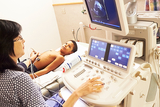What is bicuspid aortic valve?
The heart has four chambers and four valves. Blood passes through a valve before leaving each chamber of the heart. Heart valves are made of flaps of tissue called leaflets. These leaflets work like one-way doors, opening to let blood move forward and closing to keep blood from flowing backward.
The heart’s lower chambers are called ventricles. The left ventricle pumps oxygen-rich blood through the aortic valve and into the aorta, the largest artery in the body. Blood travels from the aorta to blood vessels throughout the body, delivering oxygen and nutrients.
The aortic valve is located between the left ventricle and the aorta. A healthy aortic valve has three thin leaflets. A bicuspid aortic valve has two leaflets. These leaflets may be thick and can cause the aortic valve to be too narrow.
If the bicuspid aortic valve is too narrow (called aortic stenosis), it can block blood flowing out of the heart. This causes the heart to work harder to pump enough blood to the body. Aortic stenosis can range from mild to severe.
If the leaflets of the aortic valve don’t close all the way, some blood can leak back into the left ventricle. This is called aortic regurgitation, (also known as aortic valve regurgitation or aortic valve insufficiency). Aortic regurgitation can range from mild to severe.
Sometimes, the walls of the aorta can become thin or too wide (dilated). This condition needs to be monitored by your cardiologist.
Signs and symptoms of bicuspid aortic valve
If your child has mild aortic stenosis or mild aortic regurgitation, they may not experience symptoms, especially in infants or young children. If your child has progressive aortic stenosis or regurgitation, they may experience some or all of these symptoms:
- Fatigue
- A heart murmur, which is an abnormal heart sound when a doctor listens with a stethoscope
Sometimes, symptoms may include:
- Chest pain
- Fainting
- Arrhythmias, or abnormal heart rhythm
- Inability to exercise without tiredness
Testing and diagnosis of bicuspid aortic valve
In the Cardiac Center at Children’s Hospital of Philadelphia (CHOP), a bicuspid aortic valve is usually diagnosed after a child has been referred by their pediatrician. Diagnosis may require some or all of these tests:
- Pulse oximetry, which is a non-invasive way to monitor the oxygen content of the blood
- Chest x-ray
- Electrocardiogram (EKG or ECG), which is a record of the electrical activity of the heart
- Echocardiogram (also called echo or ultrasound), which is when sound waves create an image of the heart
- Exercise stress test
- Cardiac MRI, which is a 3D image that shows the heart's abnormalities
Sometimes, cardiac catheterization will be required. A thin, flexible tube (catheter) is inserted through a vein or artery in the leg and into the heart to provide detailed information about the structure and function of the heart and lungs.
Treatment for bicuspid aortic valve
Treatment for a bicuspid aortic valve depends on how severe the narrowing (stenosis) or leakiness (regurgitation) is. If mild, treatment isn't usually necessary. Your child will need regular checkups with their cardiologist. They may also be prescribed medication if stenosis or regurgitation gets worse.
More severe cases of aortic stenosis or regurgitation may require surgery to repair.
Valvuloplasty
Depending on your child’s age, needs and valve structure, doctors may try to fix the valve or improve how it works using a surgical procedure called valvuloplasty.
Artificial valve surgery
Another treatment option is replacing the valve with a mechanical (artificial) one. If this happens, your child will need to take blood-thinning medicine for life to help prevent blood clots.
Ross procedure
A third option is the Ross Procedure. In this surgery, the doctor replaces the aortic valve with the child’s own pulmonary valve, then replaces the pulmonary valve with one from a donor. This allows the new aortic valve to grow with the child and doesn’t require blood thinners.
Outlook for bicuspid aortic valve
Thanks to huge advances in medicine and technology, most children with a bicuspid aortic valve grow up to live healthy, active lives as adults.
Follow-up care for aortic valve
Through age 18
Children with a bicuspid aortic valve require regular checkups with a pediatric cardiologist. Some children have to stay on medication and limit their physical activity.
Into adulthood
Bicuspid aortic valve can cause health problems in adults. It is very important that adults with this condition are monitored by a cardiologist regularly for the rest of their lives.
Our pediatric cardiologists follow patients until they are young adults. The Philadelphia Adult Congenital Heart Center, a joint program of CHOP and Penn Medicine, meets the unique needs of adults who were born with heart defects. At CHOP’s Cardiac Center, we support our adolescent and young adult patients through a smooth and seamless transition to adult cardiology care at the Philadelphia Adult Congenital Heart Center or, if desired, to a cardiologist with congenital heart disease expertise in another location.

Patient Outcomes at the Cardiac Center
Children’s Hospital of Philadelphia's pediatric heart surgery survival rates are among the best in the nation.
Resources to help
Cardiac Center Resources
We know that caring for a child with a heart condition can be stressful. To help you find answers to your questions – either before or after visiting the Cardiac Center – we’ve created this list of educational health resources.
